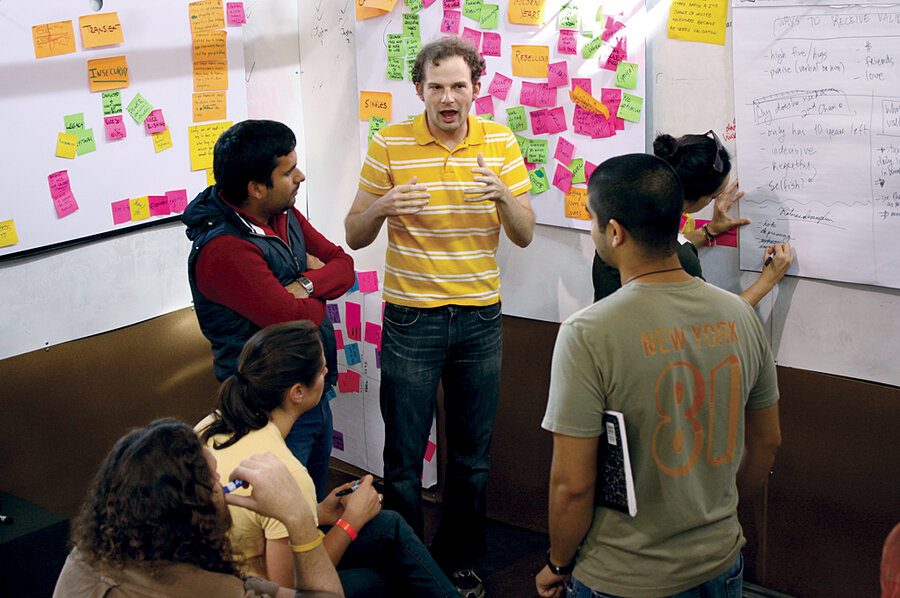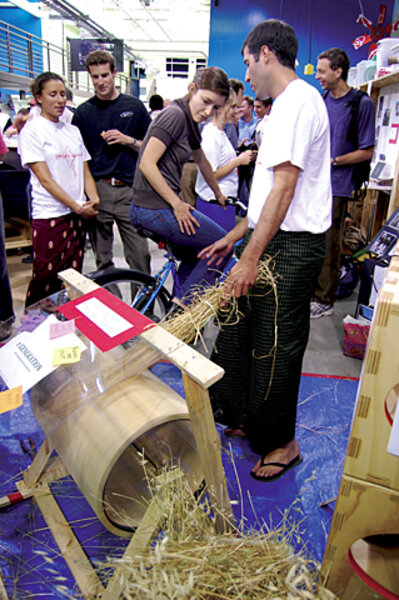Stanford's Institute of Design: School for world changers
Loading...
This school doesn't really have classrooms. In fact, Stanford University's Institute of Design in California isn't really a "school," jokes Prof. Jim Patell. Instead of classrooms, there are clusters of discussion and activity. Instead of blackboards, its walls come covered in massive sheets of white paper, design sketches, and countless Post-it notes. Instead of relying on final exams alone, the program measures success by how its students improve lives in the developing world.
Stanford's Institute of Design, more commonly referred to as d.school, specializes in pooling students from all different areas of study. Here, public-policy wonks mix with computer scientists, engineers, and medical students. Despite its quirks, or rather because of them, students compete for seats in d.school classes – compete for a chance to step outside academia and start changing the real world.
"There's a lot of brilliant students at Stanford," says Sunny Jeon, a PhD candidate at the university in Stanford. "So, when you put them all together in a class that pushes them to innovate and develop practical solutions to the world's problems, you get some really interesting ideas and feel like your work can make a difference in somebody's life."
Mr. Jeon recently returned from Kenya, where he worked on his d.school project before the new semester begins this month.
He's developing a crowdsourcing system with two classmates – policy-focused Katharine Hoffman and computer scientist Anuraag Chigurupati – that will enable people in Kibera to locate clean sources of water using mobile phones.
The d.school identifies problems and solutions by examining the intersection of human values, technology, and business. Jeon's project reflects this approach: a community focus, looking at underserved areas, taking advantage of mobile phones (the most common computer in many parts of the world), and aiming for low-cost solutions.
Professor Patell drills that last point home in his "Entrepreneurial Design for Extreme Affordability" class, one of d.school's original classes. This year, he's had 90 applicants for just 40 spots. Patell, one of the institute's seven cofounders, has been teaching students how to build products for underserved markets for eight years.
In the process, students have traveled to Ethiopia, Cambodia, Indonesia, Nepal, and Rwanda for research and development. It's all part of d.school's "empathy driven" approach to business.
Such explorations have led to products like a low-cost infant warmer to decrease the number of newborn deaths, solar devices for the poor in rural India and Africa, and irrigation systems for small-plot farmers. (See a roundup of success stories, bottom right, next page.)
To find the right blend of students each year, Patell says he selects candidates with the skills to tackle that year's focus – be it agriculture, health, or environmental technology. But the most important attribute, he says, is a "strong desire to make things." D.school's passion for design, innovation, and entrepreneurship relies on that kind of hands-on approach.
Patell doesn't just look for the right students, but also the right partners outside Stanford. "Eventually, we work hard because we become so attached to our partners," he says. "We very much want them to succeed."
Nonprofit entrepreneurs Jim Taylor and Debbie Aung Din, in particular, have become popular collaborators for the students in Patell's course. The husband-wife team runs Proximity Designs, which works with rural Burmese farmers.
Patell's students have designed several products for the organization, such as low-cost, tripod irrigation pumps in 2006. When the pump launched in Myanmar (Burma), Proximity sold nearly 5,000 pumps in the first six months. That success led to future collaborations. And now, when Mr. Taylor and Ms. Din visit the Bay Area, they regularly stay with Patell and discuss upcoming projects with his students.
Bringing together students with nonprofit collaborators, says Stanford political science professor Joshua Cohen, is what helps his classroom thrive. Even though these students are crafting prototypes for business, many of them do not have a business background. Rather, the emphasis is on "empathy driven" research, requiring students to understand the individuals they're designing for.
Dr. Cohen, who teaches "Designing Liberation Techniques" with computer science professor Terry Winograd, works closely with students to develop mobile-based solutions.
Their latest project, M-Maji, is what sent Jeon to Kenya. There, he and his fellow students worked with the Nokia Africa Research Center; the University of Nairobi's computer science department; and the Umande Trust, a nonprofit organization addressing water and sanitation issues in Kenya.
Working in small, interdisciplinary teams, students designed mobile-based programs similar to M-Maji in an intensive 10-week course led by Cohen and Dr. Winograd this past school year.
The result: six different ideas, ranging from a text-message-based system for prenatal care to digitizing data collected by health workers in Kenya.
But putting these ideas on paper isn't enough. Cohen emphasizes that the course is about "trying, not talking."
Teaching frugal innovation is not limited to the d.school. Silicon Valley's start-up spirit has created similar courses at nearby Santa Clara University and University of California, Berkeley.
Tapan Parikh, a professor at Berkeley's School of Information, has been teaching an interdisciplinary course on information communication technology for social enterprise for the past two years.
He attributes the emergence of these workshop-style courses to a growing interest in new markets, fresh technologies, and a blending of the two with a social mission.
"There's definitely more demand than the course can afford," says Dr. Parikh. "But, yes, this is definitely associated with the growing interest in social enterprise. What students are realizing is that they can work full time on work that's fulfilling, socially rewarding, and aligned with their values. And they can do it in firms and with job titles and salaries that are very comparable to their peers'."
Parikh's course gave rise to NextDrop, a for-profit company that aspires to resolve water-distribution problems in developing countries such as India. Shortly after completing their pilot testing, three of his students were awarded a $375,000 grant by the Knight Foundation.
Yasser Bhatti, who will take a semester away from Oxford University's Said Business School to join d.school this fall, says that much of the allure of these new programs comes from how they give students the resources – financial and academic – to put their ideas into action. "It gives you a sense of 'I'm in control; I can make a difference,' and that the results would be immediate, no matter how small or big they might be,' " he says.
Compared with a "bleaky" desk job at the United Nations, where Mr. Bhatti had worked before, the "self-empowerment and control in innovating and commercializing solutions," he says, "is what makes students opt" for programs such as d.school.
George Kembel, d.school's director, sees a growing fervor for innovation among students. They created d.school, he says in an e-mail, because they saw design becoming a more collaborative process, "and students from across the university were hungry to see themselves as creative."
So, they gave them just that – free-form courses that have become successful incubators for student-led businesses.
[Editor's note: The original version of this story misspelled Anuraag Chigurupati's name.]






